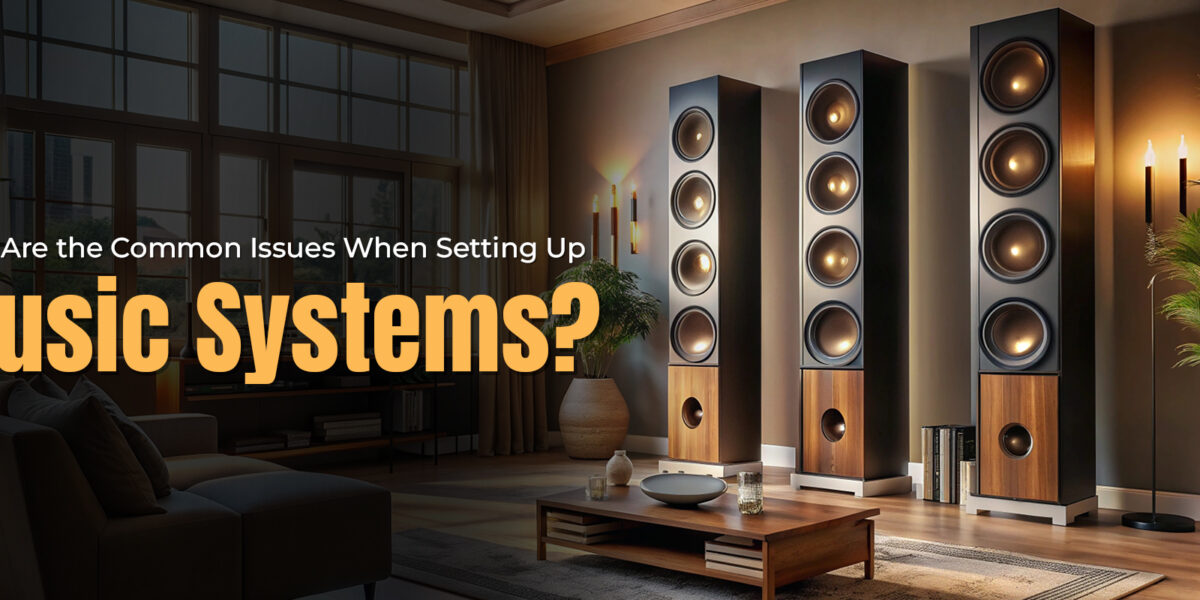Setting up a music systems can be an exciting venture, whether you’re creating a home theater, building a professional studio, or simply enhancing your living room’s sound experience. In Phnom Penh, the process might involve additional considerations specific to the local environment. However, despite the thrill, several common issues often arise during the setup process. Understanding these challenges can help you avoid pitfalls and achieve the best sound quality possible. Here’s a look at some of the frequent issues when setting up a Soft Music System in Phnom Penh and tips on how to address them.
Here are the major problems with the solution:-
Poor Placement of Speakers-
Poor speaker placement is one of the most frequent setup problems in music systems. Improper placement can result in less-than-ideal sound quality, such as unbalanced audio and diminished clarity. For the room’s sound to be distributed evenly, speakers must be positioned carefully.
Solution: Position speakers at ear level and avoid placing them directly against walls or in corners, as this can cause unwanted bass reflections. Use the rule of thirds to place your main speakers and ensure they are equidistant from your listening position for balanced audio.
Inadequate Room Acoustics-
The acoustics of your room play a significant role in how well your music system performs. Hard surfaces can cause excessive reflections and echoes, while soft furnishings can absorb sound and reduce clarity.
Solution: Consider using acoustic treatment materials like foam panels or diffusers to manage sound reflections. Rugs, curtains, and upholstered furniture can also help absorb excess sound and improve overall acoustics.
Incorrect Wiring and Connections-
Improper wiring and connections can lead to a range of issues, including poor sound quality and even damage to your equipment. This includes using the wrong type of cables or failing to connect components correctly.
Solution: Ensure that all cables and connectors are properly matched to your equipment. Follow the manufacturer’s instructions for wiring and connections, and double-check all connections before powering up your system.
Incompatible Components-
Using components that aren’t compatible with each other can result in various issues, such as poor performance or system failures. This is particularly important when integrating different brands or types of equipment.
Solution: Verify compatibility between all components before purchasing. Check the specifications of your amplifier, speakers, and other equipment to ensure they work together harmoniously. Consulting with a professional can also help avoid compatibility issues.
Overloading the System-
Pushing your system beyond its limits can lead to distortion and potentially damage your equipment. This often occurs when the system is not properly calibrated or if the components are mismatched.
Solution: Adhere to the recommended power ratings for your speakers and amplifier. Avoid setting volume levels too high and calibrate your system using any available calibration tools or software to ensure optimal performance.
Neglecting System Calibration-
Failing to calibrate your system can lead to poor sound quality and an imbalanced listening experience. Calibration ensures that your system delivers the best possible sound based on your room’s acoustics and speaker placement.
Solution: Use calibration tools or software to adjust your system’s settings. Many modern receivers come with automatic calibration systems that help optimize sound quality based on the room’s acoustics.
Ignoring Source Quality-
The quality of your audio sources can significantly impact the performance of your music system. Low-quality sources can result in degraded sound quality, regardless of how well your system is set up.
Solution: Use high-quality audio sources and ensure that your playback devices support high-resolution audio formats. Invest in good-quality media files or streaming services to fully utilize your system’s capabilities.
Inadequate Power Supply-
An unstable or inadequate power supply can affect the performance and longevity of your music system. This can lead to inconsistent performance or even damage to your equipment.
Solution: Ensure that your power supply is sufficient for your system’s needs. Use surge protectors to safeguard your equipment from power surges and outages.
Ignoring Room Layout-
Your room’s layout can affect how sound bounces off objects and travels through them. Ignoring the room layout can lead to uneven sound distribution and other audio issues.
Solution: Consider the room’s layout and adjust your speaker placement accordingly. Experiment with different positions to find the optimal arrangement that offers the best sound Failure to Update Firmware
Outdated firmware can cause compatibility issues and limit the functionality of your music system. Updates are frequently released by manufacturers to enhance functionality and provide new features.
Solution: Regularly check for firmware updates for your equipment and install them as needed. This helps ensure that your system operates smoothly and benefits from the latest improvements.
Conclusion:
Setting up a music system involves more than just connecting components; it requires careful consideration of placement, acoustics, compatibility, and more. For those seeking expert assistance, Professional Audio Services in Phnom Penh can provide valuable support. By addressing these common issues with professional guidance, you can create a music system that delivers exceptional sound quality and provides an immersive listening experience. Whether you’re a seasoned audiophile or a casual listener, taking the time to address these potential pitfalls with the help of professionals will help you enjoy your music to the fullest.




Comments are closed.